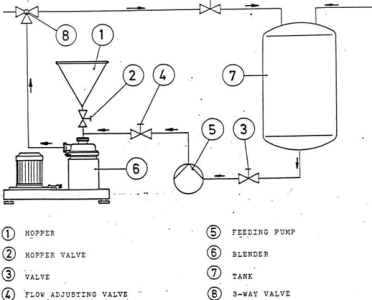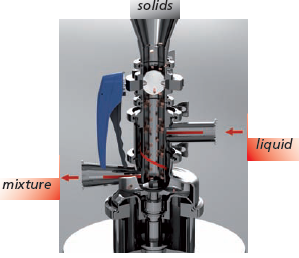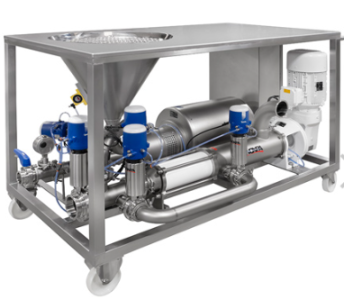Blender Systems (Liquid – Powder Mixing Systems)
Blender systems are mixing and blending equipment used in industrial processes. They are generally used in chemical, food, pharmaceutical, cosmetics, cement, plastic and other similar industries. Blender systems are used to obtain a homogeneous mixture of different materials. Blender systems, which are generally used in the ice cream, milk, fruit juice, cosmetics and chemical sectors, provide different advantages with the use of different equipment in each production branch.
 Blender systems generally consist of a funnel-shaped chamber to allow the powder material to enter the system and a piece mounted at the bottom of this chamber to allow liquid material to enter. In order to ensure adequate mixing, it is necessary to pay attention to the following conditions.
Blender systems generally consist of a funnel-shaped chamber to allow the powder material to enter the system and a piece mounted at the bottom of this chamber to allow liquid material to enter. In order to ensure adequate mixing, it is necessary to pay attention to the following conditions.
Necessary conditions to ensure adequate mixing in blender systems
- To ensure the flow of the powder material through the existing funnel depending on its structure and moisture retention.
- To ensure that the existing liquid entry point meets the powder material in a circular flow, at the mixing mouth.
- Support the system with circulation or an extra mixer for homogenization of the mixture result
 The powder structure written in the first article is very important for the mixture. If the powder does not go down easily in the funnel, a vibration device should be added to the funnel.
The powder structure written in the first article is very important for the mixture. If the powder does not go down easily in the funnel, a vibration device should be added to the funnel.
The connection diameter and angle at the current fluid entry point ensures that the liquid is mixed at the mixer mouth by making a circular movement at high speed.
If the liquid and powder substances to be used can dissolve in each other at first encounter, the standard single-pump model without mixer can be used.
However, if there are problems such as clumping or sticking during this first encounter, the blender system should be supported with an inline mixer.
If the viscosity of the homogeneous mixture formed is high, we can provide a mixture of up to 15,000 cpu without straining the system with our new design PB Series (supported by monopump) blenders.

We can use the following options in all blender systems
- FPM seals.
- DIN, SMS connections.
- Chamber vibrator.
- Automatic valve + low solid level hygienic sensor.
- Automatic butterfly valves on blender and pump.
- Hygienic sensor with high solid level.
- Bypass pump.
- Control panel with controls for vibrator, solid level sensors and automatic valves.
- Grid for hopper.
- Vacuum manometer.
- Anti-vibration feet.
The main components of blender systems are:
- Mixer: Mixer is the basic component used to mix ingredients and obtain a homogeneous mixture. Mixers usually have rotating impellers or paddles to ensure material flow and mixing of ingredients.
- Engine: The engine that provides power for the operation of blender systems rotates the mixer. The motor is usually an electric motor and may be variable speed to control the rotation speed of the mixer.
- Shaft: It is the component that connects the mixer to the engine. The shaft transmits the rotational movement of the motor to the mixer, allowing the materials to be mixed.
- Control System: These are the components that control the operation of the blender system. This system may include a control panel or computer interface to adjust rotation speed, operating time and other parameters.
- Tank: It is the tank or chamber in which the mixture will be made. This tank should generally have suitable features for mixing and storing materials. Tanks can be produced from different capacities, shapes and materials.
Blender systems are commonly used to ensure a homogeneous mixture of ingredients. For example, it is used in various applications such as combining different ingredients in the chemical industry, dispersing active substances in the pharmaceutical industry or homogeneously mixing ingredients in the food industry.
Blender systems come in various types for different applications. Here are some common blender types:
- Static Mixers: Static mixers are blender systems that do not have rotating parts and rely on the fluid itself to mix. These types of blenders perform mixing by changing the speed and orientation of the fluid. Some common types of static mixers are tube mixers, injection mixers, and sheet mixers.
- Rotary Blenders: Rotary mixers are blending systems that have a mixer rotating on a shaft. These types of blenders move and mix ingredients to ensure homogeneity of the mixture. Rotary mixers are generally used in horizontal or vertical cylindrical tanks. There are different types of rotary mixers such as propeller, paddle or double cone.
- Spiral Mixers: Spiral mixers are blender systems that mix ingredients using a rotating spiral or screw. These types of blenders move ingredients up and down while also providing rotational motion. Spiral mixers are generally used for mixing dense materials.
- Immersion Mixers: Immersion mixers are blender systems in which ingredients are mixed in a submerged tank. These types of blenders mix ingredients via a rotating shaft or paddles. Immersion mixers are generally used in small-scale laboratory applications and processes that require specialized mixing.
- Vacuum Mixers: Vacuum mixers are blender systems where vacuum is applied during mixing. Vacuum reduces bubble formation and ensures more homogeneous mixing of ingredients. These types of blenders are used in the production of delicate mixtures and mixing air-sensitive materials.
This only covers some basic blender types, and more specific and specialized blender types may be available depending on industry needs and applications.
 Stainless Steel Products
Stainless Steel Products Mixing
Mixing Pumps
Pumps Heat Exchangers
Heat Exchangers System Solutions
System Solutions